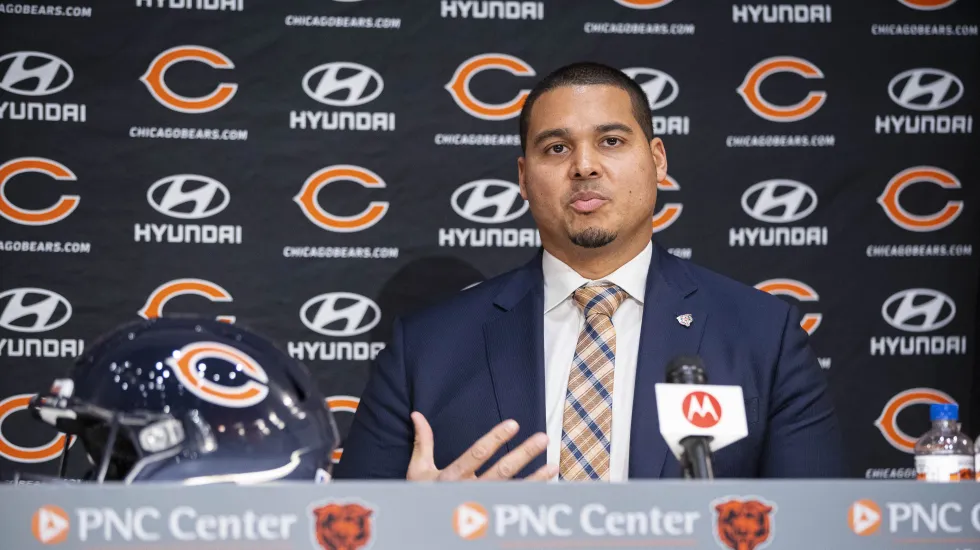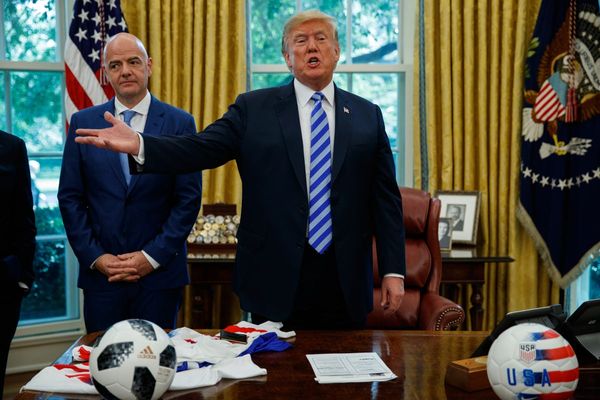
The NFL’s league year began exactly one month ago. Fans longing for the Bears to finally make a splash are forgiven for thinking it has been twice as long.
Ryan Poles’ first offseason as general manager has been characterized more by what he has subtracted than by what he has added. Poles traded Khalil Mack to the Chargers for a second-round pick, cut a cadre of veterans and decided not to re-sign receiver Allen Robinson or defensive tackle Akiem Hicks. He agreed to add defensive tackle Larry Ogunjobi as the team’s major free-agent expenditure, but the deal fell apart days later when the Bears found his medical report unacceptable.
Poles signed just four players to two-year contracts — center Lucas Patrick, defensive tackle Justin Jones, defensive end Al-Quadin Muhammad and second-string quarterback Trevor Siemian — and the rest to one-year prove-it deals.
None of those players will inspire jersey sales or dreams of greatness. Still, the Bears are building, whether it feels like it or not. A year from now, they plan for their offseason to be far more high-flying — because they’ll have lots of salary-cap space, a first-round draft pick and, they hope, an improved quarterback in Justin Fields.
Until then, they preach patience.
Chairman George McCaskey approves of Poles’ plan, even as he admits that it has been hard for him to stay patient in the past.
“If you ask a fan, ‘Should we go for it on fourth down?’ . . . they’re going to say yes every time,” McCaskey said last month. “So you have to balance your reactions emotionally and as a fan with what is necessary to begin from a football perspective — and as an executive of the team.”
As Poles prepares to lead his first draft later this month, here’s a look at the Bears’ slow build:
A genuine draft
A graphic passed around social media this week attempted to dispel the Super Bowl champion Rams’ well-worn reputation for trading draft picks. The chart showed, since 2017, only four teams had drafted more times than the Rams’ 45. All draft rounds aren’t created equal, though — the Rams haven’t made a first-round pick since 2016.
The Bears have a different problem: They’re short on quality and quantity of picks. Under former GM Ryan Pace’s “no regrets mindset,” the Bears have drafted just 31 players since 2017.
Barring a shocking trade, the Bears will go without a first-round pick this year for the third time in four seasons, thanks to deals Pace made for Mack and Fields. They are one of eight teams not scheduled to draft in the first round, though trading Mack to the Chargers landed them a second pick in Round 2.
Their recent paucity of picks goes beyond the first round. Since 2017, the Bears have gone without a third-round pick four times. They’re scheduled to be without a fourth-round pick this year, the third time that has happened in as many years.
The result has been predictable: The Bears’ talent pool is shallow and narrow. In recommending that McCaskey fire Pace and coach Matt Nagy, consultant Bill Polian said the Bears had “six or eight players you could win consistently with.” Good teams need at least 12, he said.
Mack, Robinson and Hicks are gone, cutting the Bears’ number of sure things roughly in half. The list of bankable players is down to linebacker Roquan Smith, edge rusher Robert Quinn, receiver Darnell Mooney and cornerback Jaylon Johnson. Polian didn’t count Fields, whom he gave an incomplete after one season.
Poles knows how much work is left to do with the roster. He doesn’t figure to trade from the Bears’ future stash of draft assets just to move around the board later this month.
In 2023, the Bears will own their first-round pick, which figures to be in the top 10. Poles will use it then.
Tip of the cap
The surest sign that the Bears are planning to make a grand statement in 2023 is what they’re doing — and not doing — with their cap space this season.
Trading Mack to the Chargers gave the Bears, briefly, the title of the NFL team spending the most dead cap money in 2022 — meaning that no one was paying more for players to suit up for other teams. They were eventually passed by the Texans, who will pay $16.2 million in dead cap charges after trading quarterback Deshaun Watson, and the Falcons, who will cough up a whopping $40.5 million for quarterback Matt Ryan to play for the Colts. Ryan’s dead cap charge was the largest in league history by about $7 million.
Only by that standard does the Mack trade seem small.
The Bears will pay $24 million in 2022 dead cap money for Mack’s contract, the most ever for someone who doesn’t play quarterback, followed by $5.15 million for that of nose tackle Eddie Goldman, whom Poles cut last month.
Pace structured the contracts of quarterback Andy Dalton, tight end Jimmy Graham and tackle Charles Leno — who hasn’t played for the Bears since 2020 — so that the team will have to pay about $12.4 million in dead cap money this year.
Poles’ one-year penance, though, has a payoff. The Bears have $123.7 million in projected cap space in 2023, according to Spotrac. That’s more than any team but the Texans.
Projecting free agency next March is a fool’s errand in a league that locks up most of its superstars long before they hit the market. But it’s intriguing that three of the top five potential 2023 free agents are wide receivers — the Seahawks’ DK Metcalf, the 49ers’ Deebo Samuel and the Titans’ A.J. Brown. That’s a position where the Bears desperately need a talent infusion.
Paying their guys
Poles figures to give linebacker Roquan Smith, who’s entering the final year of his rookie deal, a contract extension before he plays a regular-season snap this year.
It will cost him. In August, Colts linebacker Darius Leonard — the star of Matt Eberflus’ defense before the Bears hired him away to be their coach — signed a five-year, $98.5 million extension with $52.5 million guaranteed. The Colts could cut him after 2023 having paid him $46.8 million over three years. A month earlier, 49ers linebacker Fred Warner signed a five-year extension worth $40.5 million guaranteed and $95.2 million overall. The 49ers could cut him after 2023 having paid $42.6 million over three years.
The market for Smith seems clear: about $14 million-$15 million guaranteed per year over the first three years of his contract. Or maybe more. The Jaguars’ Foyesade Oluokun, who isn’t as accomplished as Smith, just re-signed for three years and $45 million. He’ll get $28 million guaranteed over the first two years.
Last month, Poles said that he wanted to get a deal done before the season started. He then hedged a bit, saying that having a new coaching staff could slow the process a bit.
“But if he’s the guy that I think he is, that’s something we have to address,” he said. “I think he’s a really good linebacker. And in this defense with Matt and [defensive coordinator] Alan [Williams], there’s a good chance he’s going to have a really good year.”
It speaks to the Bears’ talent drain that there are maybe two other players the team might prioritize re-signing during the season before they hit free agency: running back David Montgomery and receiver Byron Pringle. The former plays a position that modern front offices have been loath to pay for, while the latter hasn’t suited up for the Bears yet.
The Bears’ build is just getting started. There’s a lot of work to do.







